Roll For The Galaxy is dice rolling goodness
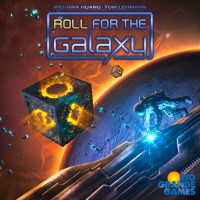
With 111 custom dice, you can expect to do a lot of dice-rolling in Roll For The Galaxy.
However, mountains of dice aren’t all that’s included in the game.
While dice rolling may be the centerpiece of the game, the game wouldn’t be complete without all the 55 double-sided tiles.
Because it’s those tiles that you’ll be working with to explore, develop, and settle throughout the game on your way to galactic victory!
Since being published this past year, we’ve heard a lot about how fun Roll For The Galaxy is. So we were really looking forward to playing it and seeing for ourselves what the hype was all about.
Well, we’ve finally had that chance and we’re now ready to tell you what we think of Roll For The Galaxy.
But in order to understand our pros and cons of the game from a family perspective, you’ll need to get a quick rundown on how the game plays.
How to play Roll For The Galaxy
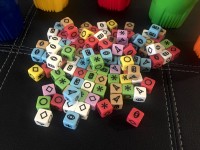
As the name implies, Roll For The Galaxy is all about building galactic empires. And like many board games or dice games, the objective is to earn the most Victory Points.
Since there are a few different ways players earn victory points, there’s plenty of decisions to be made along the way.
Now, you may think that a game with so many dice would be totally driven by luck. But that’s not the whole picture in Roll For The Galaxy because players are able to alter the outcome of some of their dice rolls.
But that’s getting ahead of ourselves already. Let’s start at the beginning.
In Roll For The Galaxy, dice represent workers who will be assigned to different tasks throughout the game. Depending on how they are assigned, they’ll do different functions – such as Explore, Develop, Settle, Produce, and Ship.
By coordinating these functions, players will expand their empire and earn victory points along the way.
Set Up
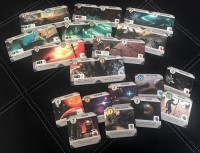
At the beginning of the game, each player will start with 5 white dice/workers. They will also receive a Player mat, a Credit Marker, a Screen, a random Faction tile, a random Home World tile, a Phase Strip, and a Dice cup.
Some players may also receive additional dice at the outset. If their Faction or Home World indicate they receive a particular color die, the players adds that to the mix accordingly. Three of the white dice immediately go into their dice cup and two go into the “Citizenry” on their player mat.
Each player then draws 2 tiles from the draw bag and places the tiles in the Construction Zone on their player mat. Since every tile is double-sided, the decisions begin immediately.
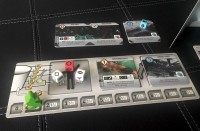
One side of the tile has a circle in the upper-left corner. This represents a World that can be settled. The other side of the tile will have a diamond icon in the upper-left corner. This side is considered a Development that will improve capabilities during the game.
Players must then choose to place one of these tiles in the World area and the other tile in the Development area of their construction zone.
Steps and Game Rounds
Roll For The Galaxy is played over a series of game rounds with players doing their actions in each step simultaneously. The steps are all spelled out very nicely on each player’s Screen. They are: Roll, Assign, Reveal, Do Phases, and Manage Empire.
1. Roll:
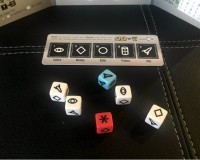
This first step is very simple. Players simultaneously roll the dice in their cups behind their player screens and see the results.
2. Assign:
This is where the dice results manipulation comes into play.
Still behind their player screen, players place each die rolled below their Phase Strip in the column matching the resulting symbol. For example, a die with a circle result will be placed below the circle symbol.
After doing so, players can choose one die and place it on any phase symbol on the strip – it doesn’t need to match.
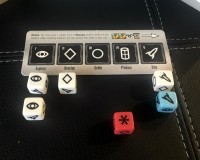
For example, a player could place a die with a Ship symbol on the Circle icon (Settle phase) on the strip.
What this means is that the player is choosing to activate the Settle Phase this round and is assigning that die as a Settle worker (settler).
In addition, a player can choose to Reassign one die/worker to another column/phase. To do so, they place one die to the right of the phase strip, then they can move another die to a column that doesn’t match the phase symbol.
After everyone has secretly rolled and assigned their workers to phases under their phase strip, it moves onto…
3. Reveal:
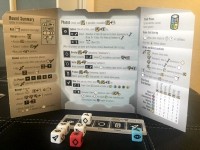
Players then remove their screens to reveal where they have assigned their workers — each announcing which phase they have selected in their phase strip.
In the middle of the table are 5 tiles representing each of the possible phases. Any phase that was selected by a player is turned over to its Active side. Any phase not selected remains on its Inactive side (“X”).
Inactive phases will not take place this round and players with dice below an Inactive phase, place them back in their dice cup. Those workers don’t have anything to do this round and have to wait until the next round to be put to work.
4. Do Phases:
For Active phases, all players that have dice/workers assigned to that phase will take on that role.
Here’s an example:

Let’s say Dad rolled 5 dice. The results were 2 Develop, 2 Settle, and 1 Ship. Dad used his Ship die to select Settle as the phase he wanted to activate. He now has 2 dice below the Develop phase symbol, 1 die on the Settle phase icon with 2 dice below the Settle phase. This means 2 Developers and 3 Settlers.
Once revealed, the Settle phase is activated because Dad chose to activate it. In addition, another player (let’s say Caleb) choose to activate Develop on their phase strip. Both Develop and Settle phases will occur this round and the 2 dice Dad assigned to be Developers will get to work even though Dad didn’t choose to activate Develop.
As long as one player choose to activate a phase, it will occur for all players who have workers assigned to that role.
The Phases activate in numerical order according to the phase tiles (the order listed below). All players will use their workers for each activated phase before moving onto the next phase.
Here is a basic rundown on the actions of each phase:

Explore — For each Explorer, the player can choose to take $2 credits or draw tiles from the bag and place them in their construction zone.
Develop — Each Developer is placed on a Development tile in the player’s construction zone. Once the amount of dice on the tile equals the value in the upper-left corner of the tile, that development is built and is placed in that player’s empire.
Settle — Each Settler is placed on a World tile in the player’s construction zone. Once the amount of dice on the tile equals the value in the upper-left corner of the tile, that world is built and is placed in that player’s empire. A newly settled world will result in a new die being added to that player’s empire.
Produce — Each Producer creates a Good (that die becomes the good) which is placed on one of the worlds in that player’s empire.

Ship — Each Shipper can take a good from a world in their empire and either Trade it or Consume it. If they trade it, they’ll get $ credits depending on the color of that world. If they Consume the good, they’ll earn victory points.
Once a worker has completed its task, it moves to the Citizenry spot on the player mat.
After all activated phases are complete, it’s time to…
5. Manage Empire
The first thing to do in this step is determine if the game has ended. If either the victory point pool is empty or any player has 12 tile squares in their empire, the game is over and it’s time to calculate scores.

If the game hasn’t ended, all players Recruit new workers in preparation for the next round.
To Recruit workers, players spend $1 Credit to put one worker/die from their Citizenry into their dice cup. Players keep recruiting workers until either their Citizenry is empty or they run out of credits.
In addition, players can Recall workers from their construction zone for free. So if they have some workers sitting on a tile in the construction zone waiting to settle a world, they can instead be called back up to the dice cup. Although this doesn’t cost any credits, it does mean one less worker towards fulfilling the cost of settling that world or developing that development.
After everyone has Recruited and Recalled workers, it’s time to dive into another round and roll those dice!
Winning the Game

Once the game ends, players add up their victory points to see who wins. There are 3 categories for earning victory points. First, are the victory point tokens earned during the game. Second, players total the value of each Development and World in their empire (not including tiles in the construction zone). Third, 6-cost developments deliver bonus victory points.
Add all those up and see who wins.
Can the whole family enjoy Roll For The Galaxy?
Although we still consider Roll For The Galaxy a good game for families to play together, we know it’s not a game everyone in the family may enjoy.
If you read through the How to Play section (and didn’t just skip to this section), you’ll quickly recognize that there’s a bit of complexity to the game. Although the player screen does a good job outlining all the steps and phases, having all that listed on the screen likewise means players need reminders of those steps and phases.

So while the colorful dice may attract younger kids in your family to the game, the symbols and game play mechanics to remember may keep them at bay.
So what about the older kids and adults?
We know this can be said for a lot of games too, but just because you can understand how to play the game, doesn’t mean you’ll enjoy it.
Games with a lot of symbols run a higher risk of alienating potential players. And even though Roll For The Galaxy technically only has 5 different phase symbols on the dice, the interplay between all the tiles, screens, mats, and phase strips will deter some players.
For example, in our family, mom and Brooke don’t have much interest in playing games that require a multi-step process to earning victory points. They also don’t have a large interest in space-themed games. So Roll For The Galaxy isn’t their cup of tea.

On the other hand, I’m for sure going to introduce Roll For The Galaxy to one of my nephews and his new bride because I know they’ll thoroughly enjoy the game. They’re big fans of games that involve multiple ways to gain points. And I know they’ll love the dice manipulation and building out an empire.
Roll For The Galaxy also gets a big thumbs up from the boys in our family.
We’re guessing the same might be true for your family — with a mix of thumbs down and thumbs up. And you won’t know for sure until you give it a try.
The Pros and Cons of Roll For The Galaxy
We’ve already mentioned a few of the Cons for Roll For The Galaxy.
For starters, there’s a bit of a learning curve to understanding the symbols and flow of play. Players who haven’t played the predecessor Race For The Galaxy, will have a bit more learning to do.
This is a category we fall into. We’ve never played Race For The Galaxy.
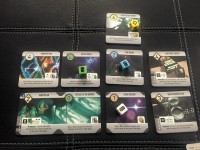
But to be honest, I don’t think that’s been a problem at all for learning the game. We’ve gone at it from scratch and the rules and game play all made sense to us right from the start.
Another Con for Roll For The Galaxy is that isn’t as fun with a low player count. Since players are at the mercy of which phases are activated each round, with less players, a lot of assigned workers go unused. (Of course, the plus side to having workers unused is that the go right back into the cup so you’ll likely have more workers to assign next round.)
There are special rules when playing with 2 players that allow a random die roll to potentially activate another phase, but we found the same issue when playing with just 3 players.
We like the game a lot more with 4 or 5 players.
Which brings us to one of the biggest Pros for the game – Simultaneous play.
Since deciding what to do with your dice results can take a bit of thinking each round, we love that the game play is simultaneous. There really isn’t much waiting for other players because the thinking happens simultaneously.
Everyone rolls their dice and thinks through how to best use them at the start of each round. Then after players reveal their choices, the different phases go by relatively quickly. There isn’t a lot of downtime during the game.
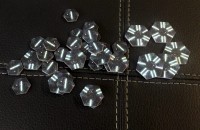
Of course, that then also reveals another Con of the game. Roll For The Galaxy can sometimes feel like a solitaire type experience. Other than determining which phases are activated (and hoping someone chooses a different phase than I do), there isn’t much player interaction.
Everyone is busy building their own empire and there aren’t ways to thwart someone else’s progress. Sure I may see that they have a number of good to ship. So I won’t want to choose to activate the Ship phase just yet. But I really can’t stop them from selecting that phase.
Likewise, if they’re working on constructing a cool development or world, I can’t do much to stop it.
Of course, the flip side to that as well is that they can’t do a lot to stop my building something cool either.
Yet, at the same time, each player relies on the others to have multiple things happen in a round. Since each player can only select one phase to activate, in order to do multiple tasks in a round everyone will be hoping that the other players select a different phase to activate.
And this guessing is a big part of the fun of the game. Trying to guess which phases the other players will activate brings in an additional strategic element. Guess right and you can chain a lot of phases together. Bingo!
We’ve also mentioned how great the player screen is with the helpful guide to all the steps and phases. Since our second play, we really don’t have to refer to the rulebook any more. Everything we need to know is on the screen.
And of course, other Pros include the cool dice, solid components, and interesting game play.
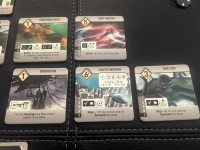
But perhaps the thing we like the most about Roll For The Galaxy are the double-sided tiles. Not only do they present interesting choices throughout the game, but they also create a big draw for repeat plays.
Deciding whether to work on the Development or the World side of a tile has been interesting every time. The benefits of each are so tempting that it can be tough to choose which to use. Should I settle it as a world and gain a new colored die or develop it for the cool ability it will generate during the game?
And for me, the fun of Roll For The Galaxy is in the myriad of decisions I make throughout the game. Every decision keeps me engaged and interested to see how it will play out. And it also leaves me anxious to play again to see what might happen next time.
How does Roll For The Galaxy score on our “Let’s Play Again” game meter?
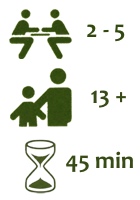 If you haven’t guessed from that last statement, Roll For The Galaxy definitely scores high on our “let’s play again” game meter.
If you haven’t guessed from that last statement, Roll For The Galaxy definitely scores high on our “let’s play again” game meter.
Of course, that goes for those of us who enjoy playing it to begin with — the boys.
While the basic game play doesn’t change from game to game, the combinations of worlds and developments that come up create a lot of replayability. Not to mention the fact that we’re still rolling dice. And even though we can manipulate them a big, the dice and sometimes be fickle and leave us begging to play “just one more time”.
Thanks Rio Grande Games for a lot of fun with Roll For The Galaxy!

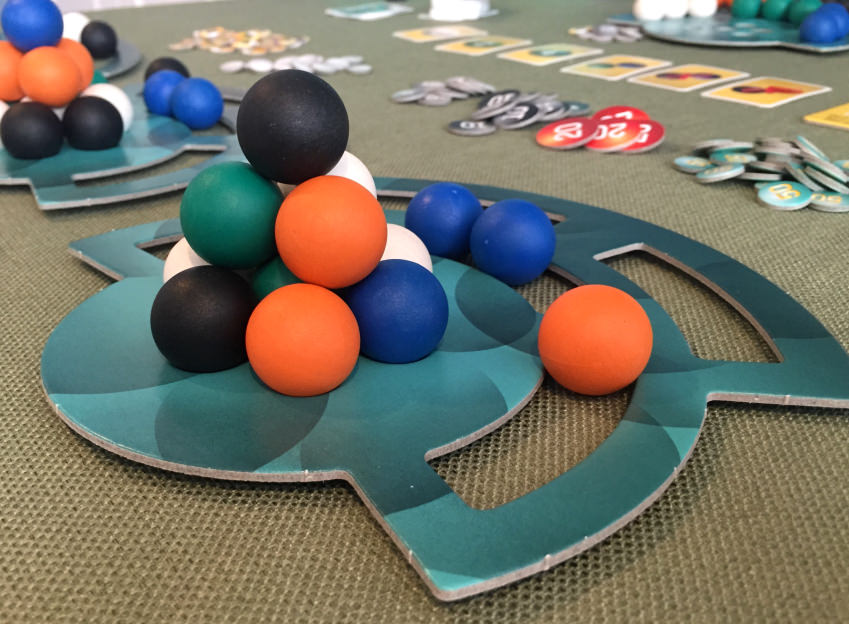

We have a very different experience in my family. I play with my wife Dani and my two daughters (5 yr and 10 yr).
We all like the game. The 5 year old plays without the screen and I have tailored a simple version of the game for her. She simply tries to do the best she can with development and world costs as VP. We don’t do special powers or anything for her and we try to reflect on how she does versus her previous games.
My 10 year old daughter is great at games, she’s been playing magic since she was 5 and I have to work hard to beat her.
But, most of the play that I have is with my wife 2 player. We have a great time and I think that perhaps you’ve over-stressed the fact that sometimes phases don’t fire off. To us, that’s just part of the strategy. You have to see what the opponent is likely to want to do and then make a guess on how to make the most of the situation.
My wife and I often play 2 or 3 games in a row because 2 player games take all of .. what? 20 minutes?
For us, it’s a lot of fun. But, in our family we often tailor the game custom for the 5 year old because her reading and abstract thinking abilities aren’t really up to the task of the more mature-targeted games like Roll.
Another thing that I like about the game is the quick setup time. It feels like BOOM we’re ready to just get started. To improve on this I made a custom inlay with a removable dice tray.
Images of inlay here:
https://sc-cdn.scaleengine.net/i/a3830cbd7976ac091222fbfe93491b4f.png
https://sc-cdn.scaleengine.net/i/437e27204403fcd66ad38cf48308617c1.png
The removable dice tray helps setup and teardown. I built it with space for the expansion which I know that I’ll be getting.
After having owned it for only 3 weeks we have played it probably 20+ times.
Anyway, just wanted to post a different experience regarding my family and to give a bit of a mention about how we custom tailor games for our 5yr old so that she can play with us and so that we can play a wider variety of games together as a family than would normally be allowed by the ‘least-common-denominator’.
Shawn – That’s great to hear!
You’re absolutely right that a big part of the strategy of the game is guessing which phase the other players are going to choose. And there can be plenty of verbal or silent cheers or moans when the screens are removed and selections revealed.
We also think it’s great how you’ve modified things a bit to give your 5 year old a fun experience tool.
And thanks for sharing a photo of the insert you’ve made. I’m a fan of making custom inserts to hold components in place well in big boxes. I know which one I’ll be making next. 🙂